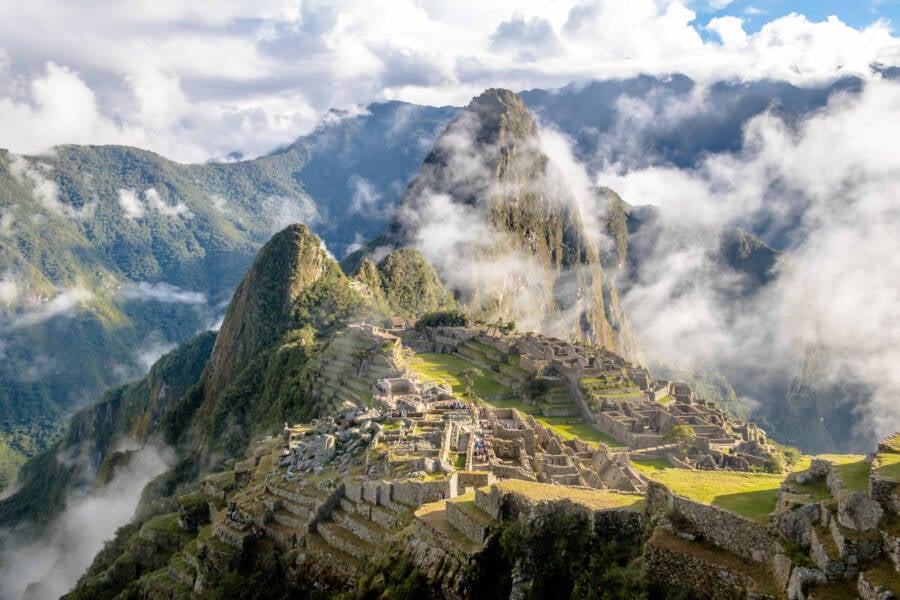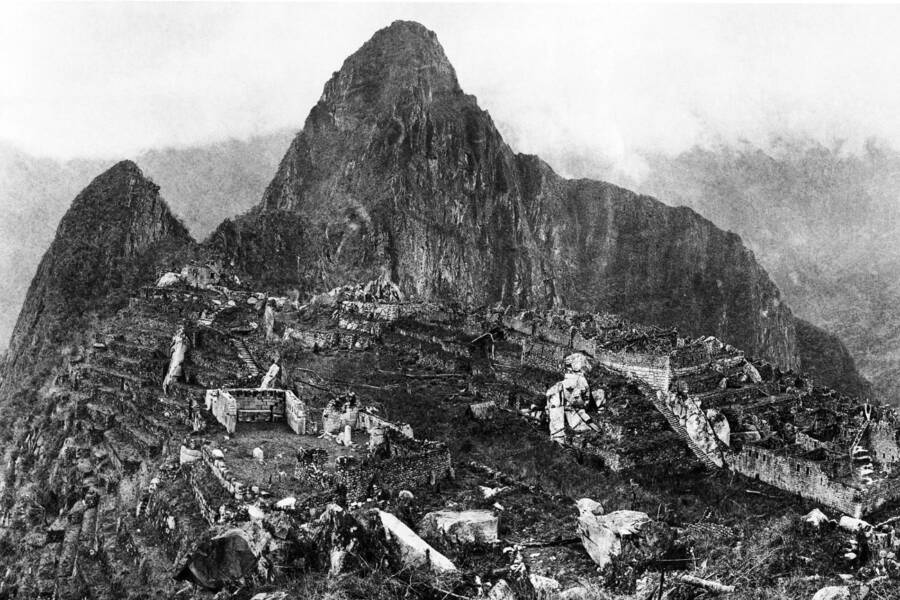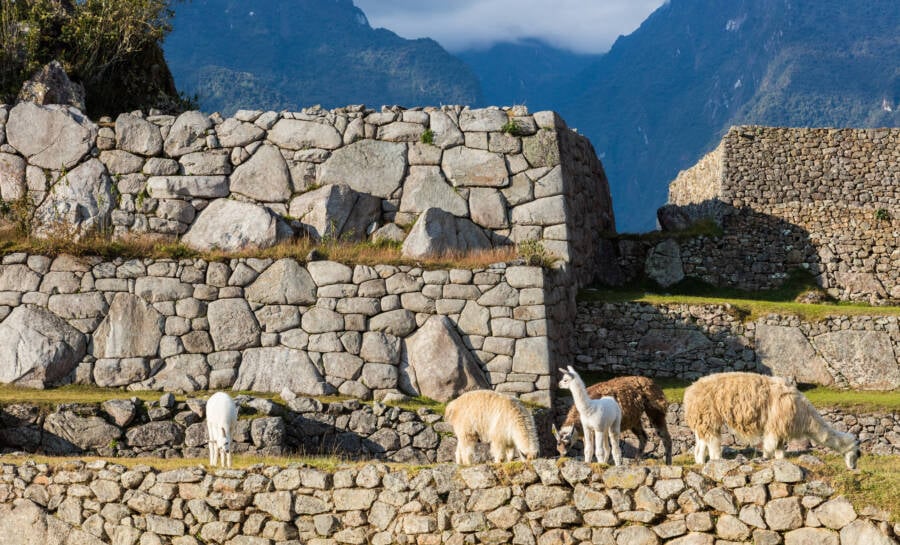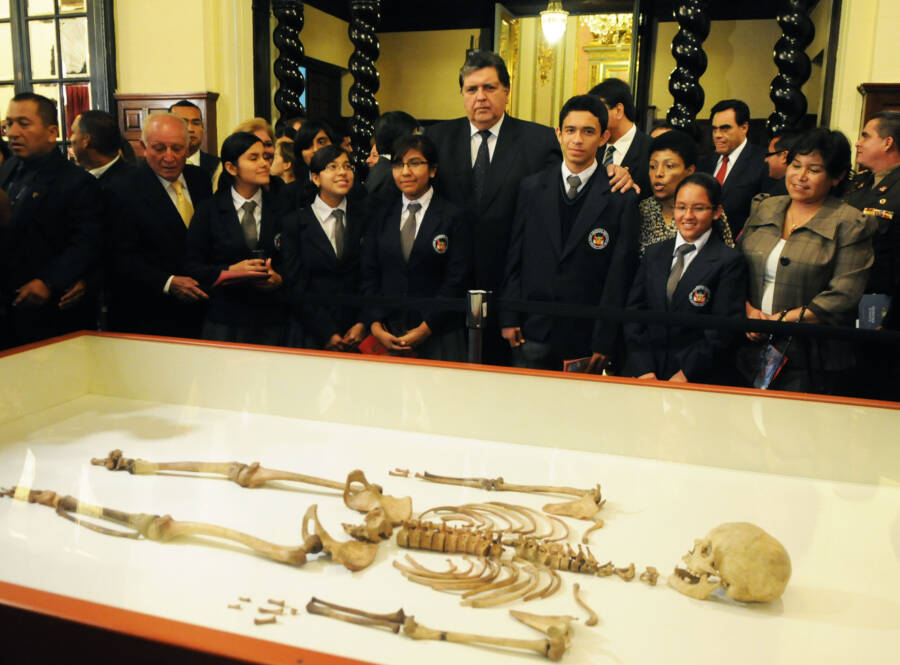While the exact circumstances surrounding the city’s construction are a mystery, most experts believe Machu Picchu was built in the 15th century on the orders of Incan Emperor Pachacuti.

Diego Grandi/Alamy Stock PhotoThe creation of Machu Picchu is credited to the 15th-century Emperor Pachacuti.
The outside world first learned of Machu Picchu in 1911, when American explorer Hiram Bingham, guided by local farmers, navigated the dense tropical forests of southern Peru and came across the ruins of an abandoned Inca city. Bingham’s work would soon kickstart a decades-long journey to discover who built Machu Picchu — and when.
Throughout the 1910s, Bingham, with support from Yale University and the National Geographic Society, would return to Machu Picchu, mapping, excavating, and photographing the stunning city. In 1913, he published an article in National Geographic, bringing global attention to the site. He later published a book entitled Lost City of the Incas, solidifying his own legacy as its “discoverer.”
Bingham was not without his controversies, however.
For starters, locals had known about Machu Picchu long before Bingham found his way there — so to call it “lost” was a bit of an exaggeration. Then, Bingham removed numerous artifacts and human remains from the site to study at Yale. While the Peruvian government gave him permission to do so, it was on the condition that the items be eventually returned — a condition that Yale largely failed to uphold for nearly a century.
It wasn’t until 1983 that Machu Picchu was classified as a UNESCO World Heritage Site and efforts to protect and revitalize the city really began. Still, Bingham’s work at Machu Picchu did reintroduce the larger world to one of the greatest archaeological sites of the Incan Empire — one that continues to fascinate historians to this day.
Hiram Bingham’s Journey To Machu Picchu
The year was 1911. Hiram Bingham, a professor of South American history at Yale University, was visiting Peru as part of the Yale Peruvian Expedition. Fascinated with the idea of exploring Inca cities, Bingham set out to find the last capital of the Incas, Vitcos.

Library of CongressHiram Bingham III, the explorer who helped introduce the world to Machu Picchu.
Bingham traveled through the Urubamba Valley, asking those he met along the way for any clues that could lead him to the historic city. Bingham later recounted his travels in an article written for National Geographic in which he described how this journey led him to Machu Picchu — all thanks to a local farmer named Melchor Arteaga, who first made him aware of the ruins.
“On the sixth day out from Cuzco we arrived at a little plantation called Mandorpampa. We camped a few rods away from the owner’s grass-thatched hut, and it was not long before he came to visit us and to inquire our business… His occupation consisted in selling grass and pasturage to passing travelers and in occasionally providing them with ardent spirits. He said that on top of the magnificent precipices nearby there were some ruins at a place called Machu Picchu…”
Bingham said Arteaga offered to guide him to the ruins for a fee of 50 cents. True to his word, Arteaga guided Bingham through the forest to Machu Picchu, which Bingham believed to be “the largest and most important ruin discovered in South America since the days of the Spanish conquest.”

Wikimedia CommonsHiram Bingham was among the first historians to try to discover who built Machu Picchu.
Over the course of several expeditions between 1912 and 1915, Bingham and other Yale researchers scoured the site of Machu Picchu, bringing back to the states countless treasures, artifacts, and even human remains.
Meanwhile, Bingham and fellow researchers mapped and cataloged the site. When Bingham wrote his 1913 National Geographic piece about Machu Picchu, he also included dozens of photographs, revealing the splendor of the Inca architecture to the rest of the Western world.

Wikimedia CommonsMelchor Arteaga crossing the Urubamba River in July 2011.
Bingham was credited with “rediscovering” Machu Picchu. However, given that he was guided there by a local, this has been widely disputed. The Spaniards may have missed Machu Picchu when they seized Inca territory in the 16th century, but locals were well aware of it long before Bingham arrived.
Still, many questions remained left to answer about the site. Thankfully, subsequent research has revealed some of its history, including who built Machu Picchu and what life was like for the people who lived there.
When Was Machu Picchu Built?
Unfortunately, the Inca civilization had no written language. As such, there was no written record of Machu Picchu’s history. Over the years, researchers have searched for other ways to unravel the mystery of its construction.
One Yale archaeologist in particular, Richard Burger, led the charge in determining who built Machu Picchu, and when. In 2004, Burger stated that he believed the Incas built Machu Picchu around the 1450s. Seventeen years later, however, his opinion changed.

Public DomainA photograph of Machu Picchu taken by Hiram Bingham in 1912.
In 2021, Burger and fellow researchers published a study in the journal Antiquity stating that Machu Picchu was actually several decades older than previously believed. Using an advanced form of radiocarbon dating known as accelerator mass spectrometry (AMS), researchers dated human remains taken from the site and revealed that it was in use from roughly 1420 to 1530 C.E.
And while the Incas may not have had a written record, there were several Spanish sources from around the time of the Spanish invasion that help to fill in some of the holes in Machu Picchu’s history. Unfortunately, many of those sources weren’t entirely accurate.
For example, historical sources stated that the Incan Emperor Pachacuti — whose reign saw the Incas establish themselves as the most prominent pre-Columbian empire in South America — rose to power in 1438. Most historians believe Pachacuti was the one who ordered the construction of Machu Picchu. And so, based on those historical records, scholars assumed Machu Picchu had been built after 1440, and possibly even after 1450.

Wikimedia CommonsLlamas at Machu Picchu.
Burger’s findings in 2021, however, show that Machu Picchu was decades older than that estimate — which indicates that Pachacuti’s reign began decades earlier than previously believed as well.
“The results suggest that the discussion of the development of the Inca Empire based primarily on colonial records needs revision,” Burger said in a Yale press release when the study was published. “Modern radiocarbon methods provide a better foundation than the historical records for understanding Inca chronology.”
But what was Machu Picchu built for in the first place?
Who Built Machu Picchu, And Why Was It Abandoned?

Wikimedia CommonsA view of the historic houses at Machu Picchu.
In the 15th century, the Incas built Machu Picchu, a mountaintop city of approximately 200 structures spread across some 80,000 acres. The city comprised palaces, plazas, residential areas, temples designed to align with the movements of the sun, a royal tomb, a guard tower, thousands of stone steps, and an intricate drainage and canal network. The estate is also surrounded by dozens of stepped agricultural terraces, which were irrigated via the city’s complex aqueduct system.
Astonishingly, the Incas built it all without the use of wheels or iron and steel tools. Thanks to their expert building techniques, the site has stood the test of time, enduring for centuries as the pinnacle of Incan architecture.
Most experts believe Emperor Pachacuti built Machu Picchu to serve as one of his estates. Researchers suspect it wasn’t his primary home, but rather a royal retreat where the ruler and his court would go to relax, hunt, and feast.
Others, however, have theorized that it functioned as a sacred pilgrimage site, where Incas would come to pay homage to their ancestors or to worship their gods.
Whatever it was used for, it was abandoned in the 16th century after about 100 years, during the period of Spanish conquest. It’s possible that the city’s inhabitants fled in fear of Spanish invaders. However, some have suggested that Machu Picchu’s population could have been wiped out by smallpox and other diseases Spaniards introduced to the region.
Either way, Machu Picchu was well hidden. Built at an elevation of 7,710 feet onto a narrow saddle between two peaks of the Andes Mountains, the sprawling estate apparently eluded outside discovery throughout the Spanish conquest and well into the 20th century — until, of course, Bingham arrived.
Unfortunately, Bingham and his fellow Yale academics didn’t conduct most of their research at the site; they took pieces of it back to America with them. This was common practice among explorers of the early 20th century, but it’s a practice that has proven to be controversial.
The Dispute Between Yale University And Peru

Wikimedia CommonsInca human remains that were repatriated to Peru.
In the 2000s, Yale University faced a wave of backlash for its collection of artifacts — and human remains — taken from Machu Picchu.
But the criticism wasn’t new. In fact, disputes over Machu Picchu’s artifacts are more than a century old. Peru had initially allowed Bingham and Yale University to “borrow” artifacts from Machu Picchu for analysis and study, on the condition that they return them to Peru when asked. That was in 1911. A decade later, most of those objects had not been returned. Many, in fact, were being kept at Yale’s Peabody Museum.
Over the years, pressure continued to mount on Yale to return the artifacts, culminating in a 2008 lawsuit in which Peru sued the university. In response, NPR reported in 2010, Yale attempted to dismiss the case by claiming that Peru had waited too long to ask for its own artifacts back, therefore waiving its rights to them.
As tensions between Peru and Yale grew, Peruvians pleaded with both the pope and then-president Barack Obama to help settle the issue. But it was ultimately a team from Yale, which included Burger, that reached an agreement with Peru’s then-president Alan Garcia to finally start returning the artifacts to Peru in 2010.
Finally, after almost exactly 100 years, Yale started shipping Machu Picchu artifacts back to Peru.
After reading about who built Machu Picchu and when, learn all about who really built the Pyramids. Then, explore the Seven Wonders of the Ancient World.





